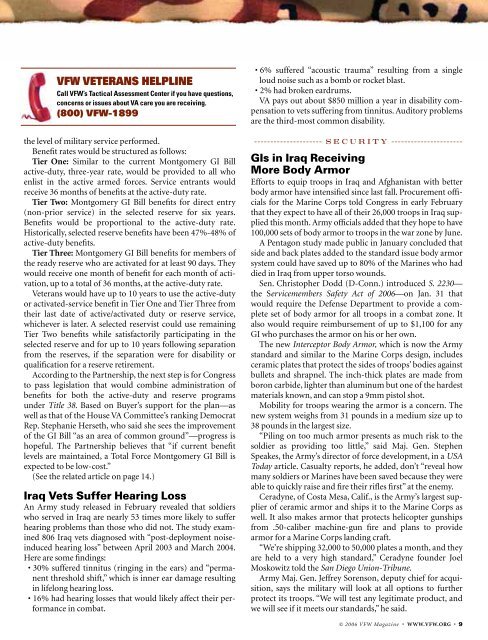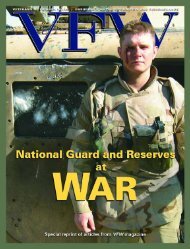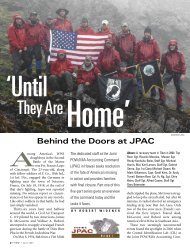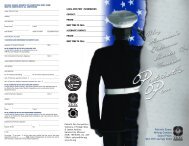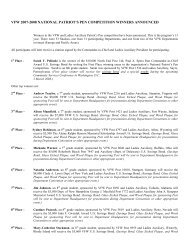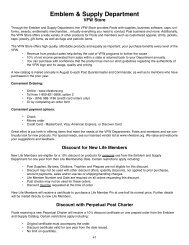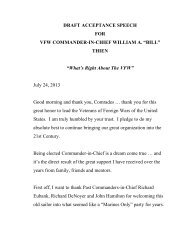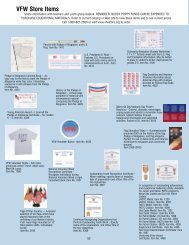2006 VFW Magazine - Veterans of Foreign Wars
2006 VFW Magazine - Veterans of Foreign Wars
2006 VFW Magazine - Veterans of Foreign Wars
Create successful ePaper yourself
Turn your PDF publications into a flip-book with our unique Google optimized e-Paper software.
<strong>VFW</strong> VETERANS HELPLINE<br />
Call <strong>VFW</strong>’s Tactical Assessment Center if you have questions,<br />
concerns or issues about VA care you are receiving.<br />
(800) <strong>VFW</strong>-1899<br />
the level <strong>of</strong> military service performed.<br />
Benefit rates would be structured as follows:<br />
Tier One: Similar to the current Montgomery GI Bill<br />
active-duty, three-year rate, would be provided to all who<br />
enlist in the active armed forces. Service entrants would<br />
receive 36 months <strong>of</strong> benefits at the active-duty rate.<br />
Tier Two: Montgomery GI Bill benefits for direct entry<br />
(non-prior service) in the selected reserve for six years.<br />
Benefits would be proportional to the active-duty rate.<br />
Historically, selected reserve benefits have been 47%-48% <strong>of</strong><br />
active-duty benefits.<br />
Tier Three: Montgomery GI Bill benefits for members <strong>of</strong><br />
the ready reserve who are activated for at least 90 days. They<br />
would receive one month <strong>of</strong> benefit for each month <strong>of</strong> activation,<br />
up to a total <strong>of</strong> 36 months, at the active-duty rate.<br />
<strong>Veterans</strong> would have up to 10 years to use the active-duty<br />
or activated-service benefit in Tier One and Tier Three from<br />
their last date <strong>of</strong> active/activated duty or reserve service,<br />
whichever is later. A selected reservist could use remaining<br />
Tier Two benefits while satisfactorily participating in the<br />
selected reserve and for up to 10 years following separation<br />
from the reserves, if the separation were for disability or<br />
qualification for a reserve retirement.<br />
According to the Partnership, the next step is for Congress<br />
to pass legislation that would combine administration <strong>of</strong><br />
benefits for both the active-duty and reserve programs<br />
under Title 38. Based on Buyer’s support for the plan—as<br />
well as that <strong>of</strong> the House VA Committee’s ranking Democrat<br />
Rep. Stephanie Herseth, who said she sees the improvement<br />
<strong>of</strong> the GI Bill “as an area <strong>of</strong> common ground”—progress is<br />
hopeful. The Partnership believes that “if current benefit<br />
levels are maintained, a Total Force Montgomery GI Bill is<br />
expected to be low-cost.”<br />
(See the related article on page 14.)<br />
Iraq Vets Suffer Hearing Loss<br />
An Army study released in February revealed that soldiers<br />
who served in Iraq are nearly 53 times more likely to suffer<br />
hearing problems than those who did not. The study examined<br />
806 Iraq vets diagnosed with “post-deployment noiseinduced<br />
hearing loss” between April 2003 and March 2004.<br />
Here are some findings:<br />
• 30% suffered tinnitus (ringing in the ears) and “permanent<br />
threshold shift,” which is inner ear damage resulting<br />
in lifelong hearing loss.<br />
• 16% had hearing losses that would likely affect their performance<br />
in combat.<br />
• 6% suffered “acoustic trauma” resulting from a single<br />
loud noise such as a bomb or rocket blast.<br />
• 2% had broken eardrums.<br />
VA pays out about $850 million a year in disability compensation<br />
to vets suffering from tinnitus. Auditory problems<br />
are the third-most common disability.<br />
--------------------- SECURITY ----------------------<br />
GIs in Iraq Receiving<br />
More Body Armor<br />
Efforts to equip troops in Iraq and Afghanistan with better<br />
body armor have intensified since last fall. Procurement <strong>of</strong>ficials<br />
for the Marine Corps told Congress in early February<br />
that they expect to have all <strong>of</strong> their 26,000 troops in Iraq supplied<br />
this month. Army <strong>of</strong>ficials added that they hope to have<br />
100,000 sets <strong>of</strong> body armor to troops in the war zone by June.<br />
A Pentagon study made public in January concluded that<br />
side and back plates added to the standard issue body armor<br />
system could have saved up to 80% <strong>of</strong> the Marines who had<br />
died in Iraq from upper torso wounds.<br />
Sen. Christopher Dodd (D-Conn.) introduced S. 2230—<br />
the Servicemembers Safety Act <strong>of</strong> <strong>2006</strong>—on Jan. 31 that<br />
would require the Defense Department to provide a complete<br />
set <strong>of</strong> body armor for all troops in a combat zone. It<br />
also would require reimbursement <strong>of</strong> up to $1,100 for any<br />
GI who purchases the armor on his or her own.<br />
The new Interceptor Body Armor, which is now the Army<br />
standard and similar to the Marine Corps design, includes<br />
ceramic plates that protect the sides <strong>of</strong> troops’ bodies against<br />
bullets and shrapnel. The inch-thick plates are made from<br />
boron carbide, lighter than aluminum but one <strong>of</strong> the hardest<br />
materials known, and can stop a 9mm pistol shot.<br />
Mobility for troops wearing the armor is a concern. The<br />
new system weighs from 31 pounds in a medium size up to<br />
38 pounds in the largest size.<br />
“Piling on too much armor presents as much risk to the<br />
soldier as providing too little,” said Maj. Gen. Stephen<br />
Speakes, the Army’s director <strong>of</strong> force development, in a USA<br />
Today article. Casualty reports, he added, don’t “reveal how<br />
many soldiers or Marines have been saved because they were<br />
able to quickly raise and fire their rifles first” at the enemy.<br />
Ceradyne, <strong>of</strong> Costa Mesa, Calif., is the Army’s largest supplier<br />
<strong>of</strong> ceramic armor and ships it to the Marine Corps as<br />
well. It also makes armor that protects helicopter gunships<br />
from .50-caliber machine-gun fire and plans to provide<br />
armor for a Marine Corps landing craft.<br />
“We’re shipping 32,000 to 50,000 plates a month, and they<br />
are held to a very high standard,” Ceradyne founder Joel<br />
Moskowitz told the San Diego Union-Tribune.<br />
Army Maj. Gen. Jeffrey Sorenson, deputy chief for acquisition,<br />
says the military will look at all options to further<br />
protect its troops. “We will test any legitimate product, and<br />
we will see if it meets our standards,” he said.<br />
© <strong>2006</strong> <strong>VFW</strong> <strong>Magazine</strong> • WWW.<strong>VFW</strong>.ORG • 9


